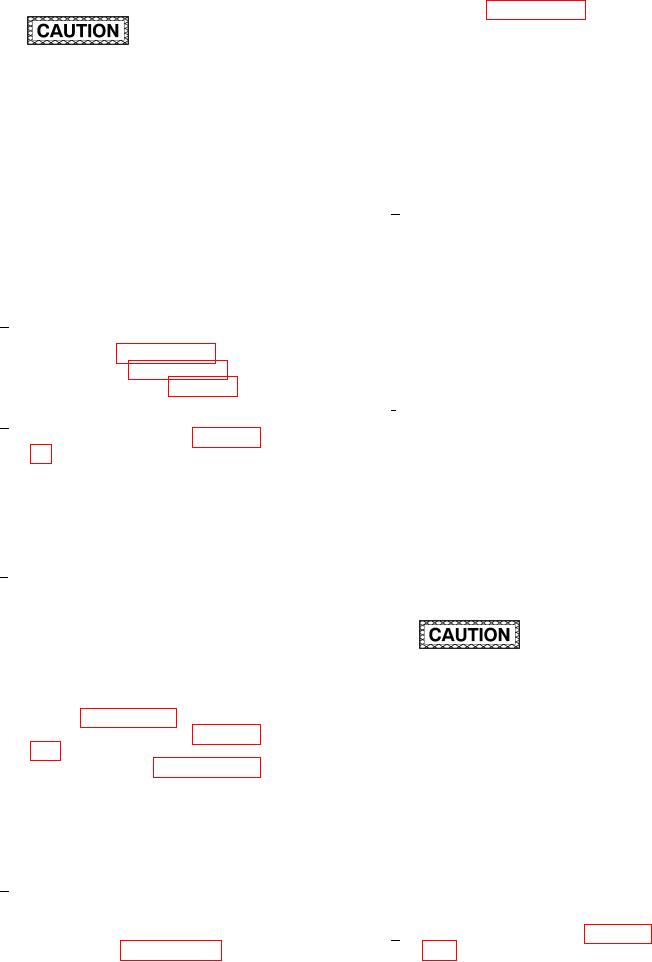
TM 1-1500-204-23-11
cloth per paragraph 6-5. Hold the
abrasive paper under the forein-
gers and reach through the dam-
aged opening. Using a side-to-side
Care must be taken to ensure a high-quality
motion, work around the circum-
bond is achieved. Failure to achieve a quality
ference of the opening until the
bond could result in loose backside seal
surface is roughened. Inspect the
components inside the aircraft and possible
sanded area using an inspection
aircraft damage due to Foreign Object Damage
mirror and a lashlight. Repeat the
(FOD).
sanding until there are no missed
areas.
The single-side access limitation causes the
backside seal to be a permanent part of the
Attach a 1/4 inch wide strip of 2
e
completed repair. It is recommended that
sided tape around the perimeter
if aluminum plates are used for the slotted
of the patch. This will hold the
discs, they should be PAA or GBS and primed.
patch in place while the adhesive
This will ensure maximum bond strength and
is curing. Wear powder free latex
reduce the potential from FOD.
gloves until patch bonding is com-
plete. If patch or spacer is not to
Remove paint from the skin in
a
be bonded immediately, cover with
the repair area by sanding as
clean barrier material and secure
described in paragraph 6-1. Clean
with preservation tape to prevent
the area per paragraph 6-5 and
inspect according to Chapter 5.
Place a piece of two-sided tape
f
on the center of the cured sup-
The laminate penetration should be
b
port patch. Attach a coil of wire to
machined according to paragraph
this tape with the end of the wire
6-8 to an oval shape according
extending at least 3 inches away
to the system speciic technical
from the patch. Attach another
manual. Ensure suficient space
piece of tape over the coil and two
is available between substructure
sided tape, irmly clamping the coil
members to allow installation of
in place. The wire is used to pull
backside patch.
the support patch up against the
inside of the part to hold the patch
Fabricate a support patch that will
c
in place while the bond adhesive
overlap the hole opening on the
cures.
inside by 1/2 inch. Use an anodized
and primed aluminum patch or fab-
ricate a pre-cured composite patch.
Cut the number of plies of dry fabric
listed in the system speciic tech-
Reduced strength will result if the incorrect
nical manual (oversize initially and
mix ratio is used, if an excessive amount
then trim back after cure accord-
of air is introduced into the adhesive during
ing to paragraph 6-8). Wet out
mixing, or if mixing is inadequate and may
with laminating resin per paragraph
result in loss of structural integrity.
6-16 and cure under vacuum and
heat blanket per paragraph 6-18
Pressure must be applied to adhesive within
using the cure cycle noted in the
the pot life of the resin. For ambient temper-
system speciic technical manual or
atures in excess of 90 F, decrease this time
recommended by the resin man-
by 50%. An unsatisfactory repair will result
ufacturer per engineering disposi-
if the resin gels before adequate pressure is
tion.
applied and may result in loss of structural
integrity. Select and prepare a heat blanket
Prepare the underside of the repair
d
(if required) and all necessary vacuum bag
cavity and both sides of patch for
materials prior to mixing resin.
bonding by lightly hand sanding
with 150-180 grit abrasive paper as
Mix the adhesive per paragraph
g
described in paragraph 6-7. Sol-
6-17. Apply pressure to adhesive
vent wipe with clean lint-free wiping
within the pot life of the resin.
6-64

